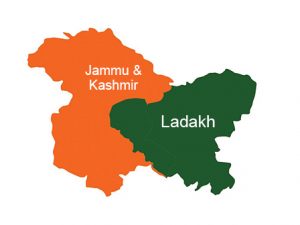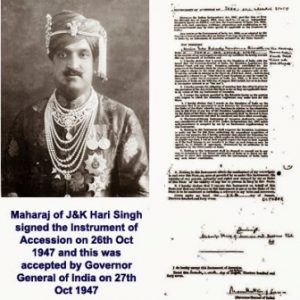26 October 1947: Kashmir Acceded to the Indian Union
In the wake of tribal Pathan attack resolved to annex Srinagar, Maharaja signed the Instrument of Accession, the legal document that led to the accession of the Himalayan state with the Indian Union.

On 31 October 2019, the most disputed state will cease to exist in its present form as Jammu & Kashmir Reorganization Act will come into force at the end of this month.The act will not only split the state into two but the constituent parts will also be converted into Union Territories (UTs), namely, UT of J&K and UT of Ladakh, both to be directly governed by the centre through its governor stationed in both the UTs.
At a time when the whole country that boasted of its diversity and religious amiability was embroiled in communal bloodshed, the Himalayan princely state of Jammu and Kashmir displayed a rare religious bonhomie.
Prior to the enforcement of Indian Independence Act on 14/15 August 1947, Maharaja Hari Singh, the hereditary ruler of the state of J&K signed a standstill agreement with both India and Pakistan on 12 October 1947, according to which neither of the two newly independent dominions could alter the status quo in the princely state. Though Pakistan signed the agreement, India did not and asked Maharaja’s delegation to visit New Delhi for negotiations. No delegation visited Delhi, hence no negotiations happened. Like his contemporaries in Travancore, Hyderabad and Bhopal, the ruler wanted his kingdom to be independent and was also averse to join either India or Pakistan.
Also Read : Fatf Retains Pakistan On Its Grey List
The conflict of Kashmir started in the autumn of 1947 when the newly created Dominion of Pakistan sent tribal Pathan Lashkars from its North-West Frontier Province (NWFP) to capture the then independent princely state of Jammu & Kashmir.A state with a Hindu ruler and a majority Muslim population is a singular example among the 584 princely states that got independence along with India and Pakistan when the Indian Independence Act came into force. About 5,000 armed tribesmen (number contested) stormed into the western city of Muzaffarabad, which is now the capital of Pakistan occupied Kashmir (PoK). The strength of the Maharaja’s army, both in numbers and in kind, was too fragile to withstand the burly armed Pathans known for their ability to fight. The Maharaja’s army also faced defections by some Muslim soldiers.The approaching Lashkars captured one area after another and turned more vicious when they resorted to plundering and arson. They pledged their allegiance to Pakistan and Islam, killing everyone who couldn’t recite the Islamic ‘kalma’, enslaving non-Muslim women, many of whom jumped into the river to save their lives and dignity.

After unleashing a reign of terror, the ferocious contingent was asked to move 170km east, to the capital Srinagar, again resorting to looting and arson on the way. Having reached Domail, Uri could be reached only through a narrow bridge, which Brig. Rajendra Singh blew up. This particular act strangulated invaders for 2 days, which gave Maharaja time to chalk out a strategy. The tribal army reached Baramullah, the entry point to Srinagar. Two days since the siege of his state began, the Maharaja called the Indian government for help on 24 October. After a meeting of Cabinet’s Defence committee, V.P. Menon, the then secretary in the Ministry of States, was sent the next day to Srinagar, with a task and a message for the Maharaja.The task was to get Maharaja and his family out of Srinagar, and the message was that the Indian state would send its forces immediately after he accede Kashmir to India. Maharaja was safely taken from Srinagar to Jammu. The capital now lay defenceless and without a ruler; Srinagar lay open for the invaders.
On 26 October, Maharaja Hari Singh, who was once averse to join either India or Pakistan, signed the ‘Instrument of Accession’ with India. The dawn of the next day, Indian troops under the command of Lt. Col. Diwan Ranjit Rai landed in Srinagar to free Kashmir from tribal infiltrators. Frustrated with the opposition, the Pathan tribesmen, who were more capable in guerrilla warfare, started facing defeat. At this point, the Pakistan army waged an attack on Srinagarto extend full-fledged support to its proxies. Resolved to defend, what was now an Indian territory, the Indian army won back areas one after the other. This continued till the winters set in and the Indian army couldn’t move any further. The line that separated areas regained by the Indian army and those still under the tribal siege defined what is now the ‘Line of Control’. This happened in the month of November.
This invasion defined the future of not only J&K but also the delicate relation between two neighbours that once formed the part of a single country. Not only the state has gone from one crisis to another, the relationship between the two nuclear-armed neighbours has also been hostile till now, other than a few instances of bonhomie.
Also Read : Article 370 Has Its Pros And Cons Just Like Other Laws
In a move, widely referred to as a blunder on the part of the then Indian PM Pt. Jawaharlal Nehru, the Kashmir issue was dragged to the then nascent United Nations on 1 January 1948. This he did on the advice of his then friend and governor-general of the dominion of India, Lord Mountbatten. With the ‘Instrument of Accession’ in his hand, he had assumed that regaining the occupied territories would be easy; however, it soon proved otherwise. According to the United Nations Security Council Resolution 47 (UNSCR47) dated 13 August 1948, a three-step resolution was chalked out. First, Pakistan troops had to vacate Kashmir. Second, the Indian army had to reduce its numbers just necessary for its defence. Third, a plebiscite needs to be held in which the people of Kashmir had to choose between the Republic of India and the Islamic Republic of Pakistan. This particular resolution is very often cited in the Pakistanis by its prime minister and the army spokesperson to journalists and common citizens. This is used to defame India regarding its obligations to hold a plebiscite in the Himalayan state. Very few are rightly aware of its own obligations to withdraw its troops from both PoK and Gilgit-Baltistan.
With Pakistan not fulfilling its obligation, continued fighting led to a ceasefire on 1 January 1949. The ceasefire line, though temporary in nature, has become a de-facto border between India and Pakistan. A state whose issue had been resolved 72 years ago with the signing of ‘Instrument of Accession’ with India has over the years become the most militarized region on the face of the earth.
